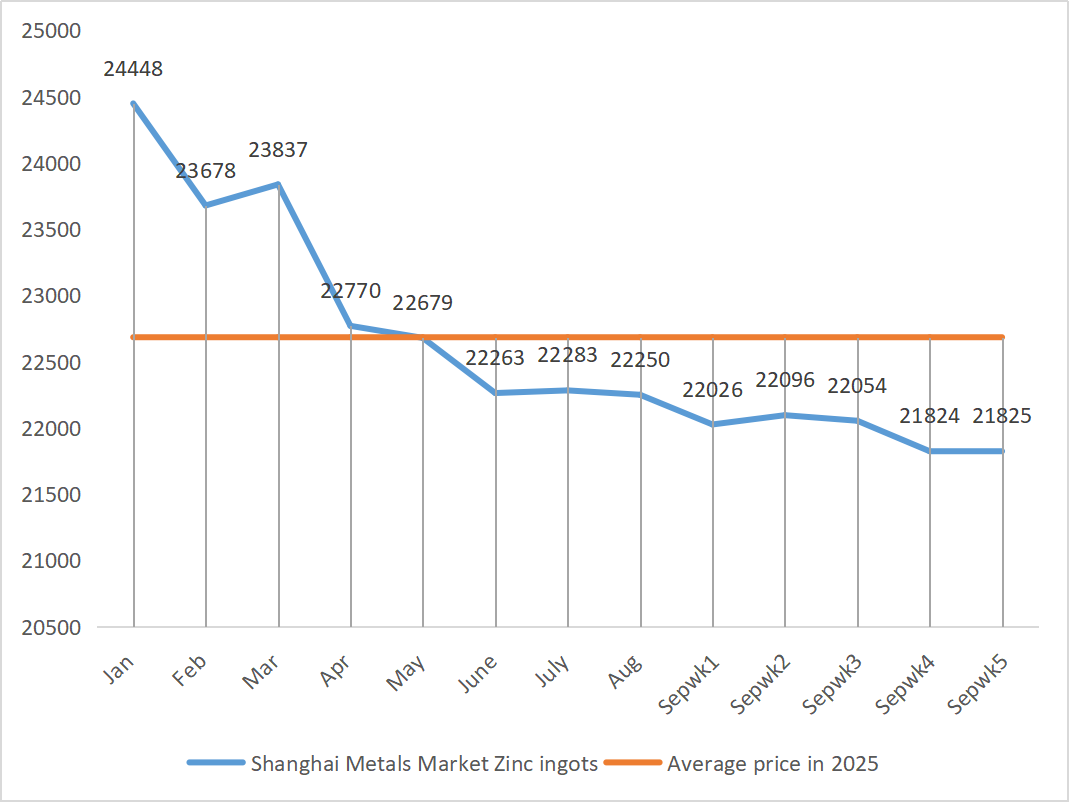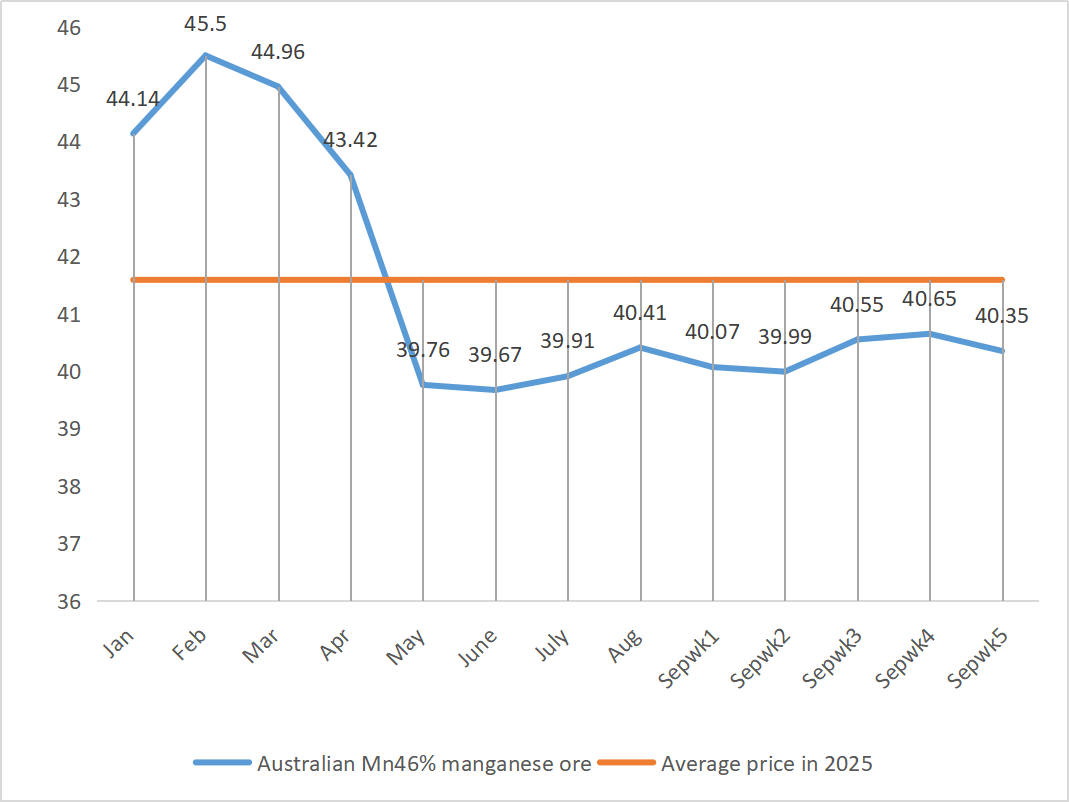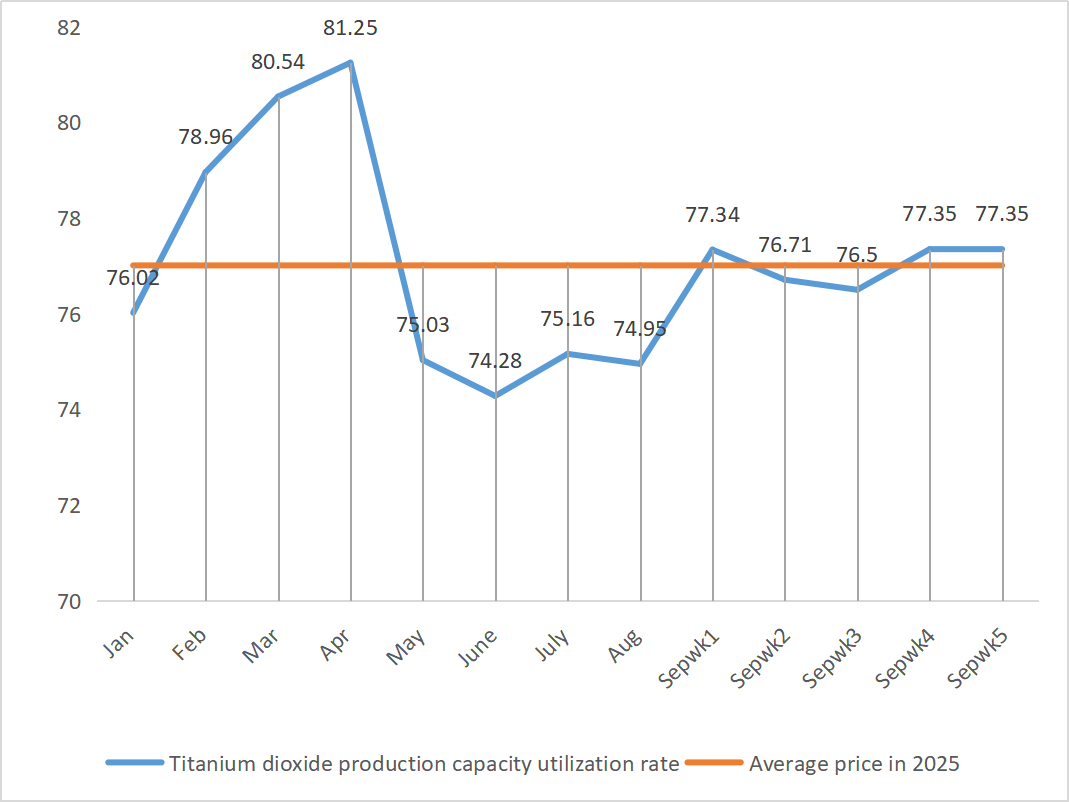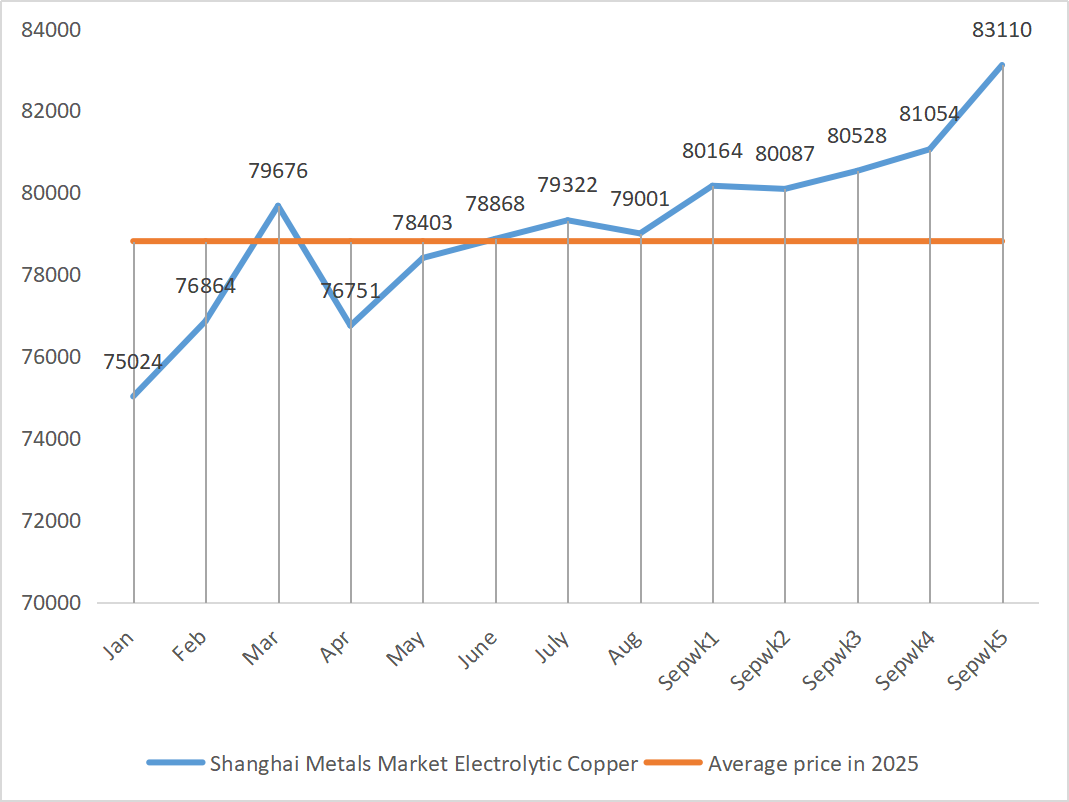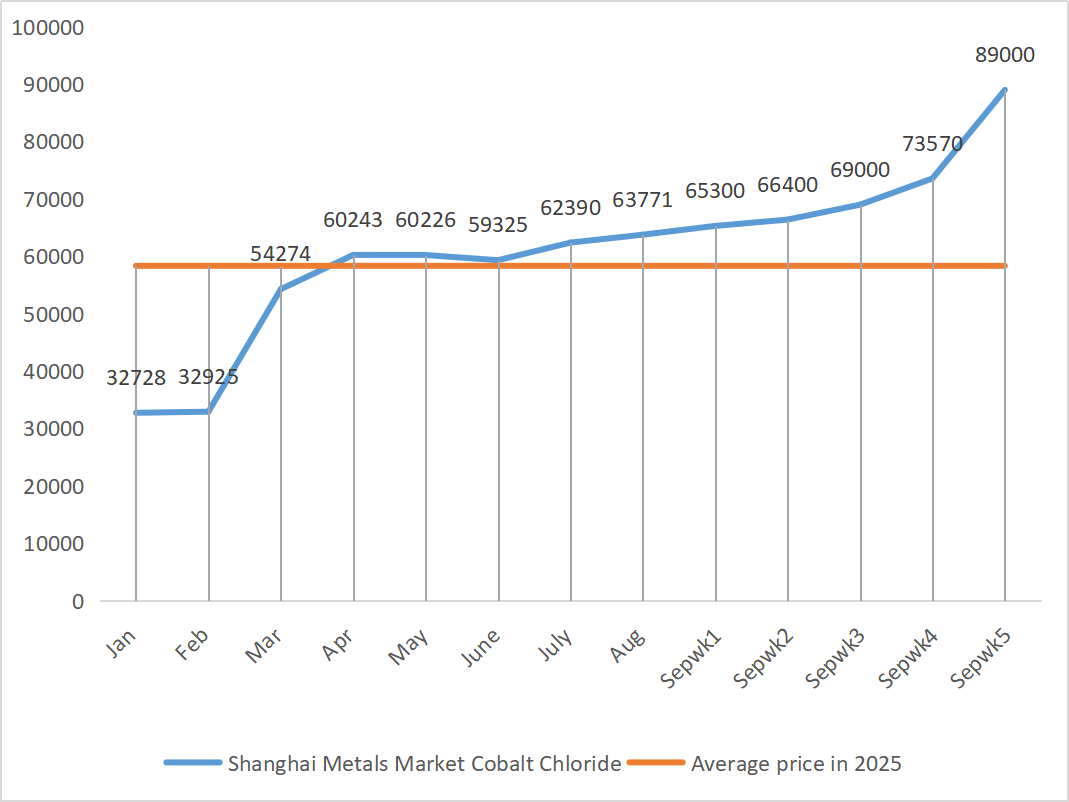Trace Elements Market Analysis
I,Analysis of non-ferrous metals
Week-on-week: Month-on-month:
| Units | Week 4 of September | Week 5 of September | Week-on-week changes | August average price | September up to 30
Average price |
Month-on-month change | Current price on October 10 | |
| Shanghai Metals Market # Zinc ingots | Yuan/ton |
21824 |
21825 |
↑1 |
22250 |
21824 |
↓426 |
22300 |
| Shanghai Metals Market # Electrolytic Copper | Yuan/ton |
81054 |
83110 |
↑2000 |
79001 |
82055 |
↑3054 |
86680 |
| Shanghai Metals Australia
Mn46% manganese ore |
Yuan/ton |
40.65 |
40.35 |
↑0.1 |
40.41 |
40.35 |
↓0.09 |
40.35 |
| The price of imported refined iodine by Business Society | Yuan/ton |
635000 |
635000 |
632857 |
635000 |
↑2143 |
635000 |
|
| Shanghai Metals Market Cobalt Chloride
(co≥24.2%) |
Yuan/ton |
73570 |
89000 |
↑15430 |
63771 |
81285 |
↑17514 |
92500 |
| Shanghai Metals Market Selenium dioxide | Yuan/kilogram |
105 |
105 |
|
97.14 |
105 |
↑7.86 |
105 |
| Capacity utilization rate of titanium dioxide manufacturers | % |
77.35 |
77.35 |
↑0.85 |
74.95 |
76.82 |
↑1.87 |
1)Zinc sulfate
① Raw materials: Zinc hypooxide: High transaction coefficient. Strong support from expectations of Fed rate cuts
This drove up non-ferrous metals. Zinc prices are expected to remain low and volatile in the short term.
② Sulfuric acid is stable this week. Soda ash: Prices were stable this week. Zinc prices are expected to operate in the range of 22,000 to 22,350 yuan per ton.
The upstream operating rate of zinc sulfate enterprises is normal, but the order intake is significantly insufficient. The spot market has experienced different levels of pullback. Feed enterprises have not been very active in purchasing recently. Under the dual pressure of the operating rate of upstream enterprises and the insufficient existing order volume, zinc sulfate will continue to operate weakly and stably in the short term. It is suggested that customers reduce the inventory cycle.
2)Manganese sulfate
In terms of raw materials: ① The manganese ore market remains cautiously on the sidelines. Factories have a surplus of pre-holiday stockpiling, port demand is average, and post-holiday transactions have not yet increased. Traders’ quotations are generally stable. At present, the fundamentals lack directional drivers, and the overall fluctuation range of ore prices is relatively narrow.
② Sulfuric acid prices remained stable across the country this week.
This week, the production rate of manganese sulfate was 31.8%/31%. The production rate was 95% and the capacity utilization rate was 56%, remaining unchanged from the previous week. The operating rate of mainstream upstream enterprises is normal. Due to the recent continuous increase in the price of raw material sulfuric acid, costs have risen slightly, and the enthusiasm of domestic terminal customers to replenish inventories has increased significantly. Based on the analysis of enterprise order volume and raw material factors, manganese sulfate is expected to remain firm in the short term. It is recommended that customers increase their inventories appropriately.
3)Ferrous sulfate
In terms of raw materials: Although the demand for titanium dioxide has improved compared to the previous period, the overall sluggish demand situation still exists. The backlog of titanium dioxide inventories at manufacturers persists. The overall operating rate remains at a relative position. The tight supply of ferrous sulfate heptahydrate persists. Coupled with the relatively stable demand for lithium iron phosphate, the tight raw material situation has not been fundamentally alleviated.
This week, the operating rate of ferrous sulfate producers was 75%, and the capacity utilization rate was 24%, remaining flat compared to the previous week. Producers are scheduled until November – December. Major manufacturers have cut production by 70 percent, and quotations remain high this week. In addition, the supply of by-product ferrous sulfate is tight, the cost of raw materials is strongly supported, the overall operating rate of ferrous sulfate is not good, and there is very little spot inventory of enterprises, which brings favorable factors for the price increase of ferrous sulfate. Considering the recent inventory of enterprises and the operating rate of upstream, the possibility of a short-term increase in ferrous sulfate cannot be ruled out.
4)Copper sulfate/basic cuprous chloride
Raw materials: Frequent disruptions on the supply side of copper ore, the supply and demand pattern of copper ore may shift from tight balance to shortage, coupled with the Fed entering the rate-cutting cycle and domestic being in the peak demand season of “golden September and Silver October”, copper prices are expected to enter an upward cycle.
On a macro level, the disruption of the US government shutdown, expectations of future rate cuts and recession have further raised concerns among global investors about the credit of the US dollar and US sovereign debt, which has pushed metal prices higher. Copper price range for the week: 86,000-86,980 yuan per ton.
Etching solution: Some upstream raw material manufacturers have accelerated capital turnover by deep processing etching solution into sponge copper or copper hydroxide. The proportion of sales to the copper sulfate industry has decreased, and the transaction coefficient has reached a new high.
This week, the copper sulfate producers’ operating rate was 100% and the capacity utilization rate was 45%, remaining flat compared with the previous week. Inventory: The hype at the mine end continues to heat up, and major copper mines around the world are facing production difficulties – Teck Resources of Canada has lowered its production forecast for Chile’s QB mine to 2028, and ICSG has slashed its global copper surplus forecast for 2025 from 289,000 tons to 178,000 tons due to a one-month shutdown at Indonesia’s Glasberg copper mine. LME copper inventories dropped to 139,475 tonnes, hitting a new low since late July. The return of demand to the market after China’s National Day holiday injected bullish momentum. Spot copper prices rose sharply and circulation was limited. The premium remained high. Stockholders were reluctant to sell. Downstream maintained essential purchasing. Spot prices were tight. All in all, copper prices are expected to fluctuate and strengthen in October. It is expected that copper sulfate/alkali copper will continue to fluctuate and rise in the short term. Customers are advised to stock up in light of their own inventories.
5)Magnesium oxide
Raw materials: The raw material magnesite is stable.
Magnesium oxide prices were stable this week after last week, factories were operating normally and production was normal. The delivery time is generally around 3 to 7 days. The government has shut down backward production capacity. Kilns cannot be used to produce magnesium oxide, and the cost of using fuel coal increases in winter. Customers are advised to purchase according to their needs.
6)Magnesium sulfate
Raw materials: Currently, the price of sulfuric acid in the north is stable.
At present, the operating rate of magnesium sulfate plants is 100%, and production and delivery are normal. The price of sulfuric acid is stable at a high level. Coupled with the increase in the price of magnesium oxide, the possibility of further increase cannot be ruled out. Customers are advised to purchase according to their production plans and inventory requirements.
7)Calcium iodate
Raw materials: The domestic iodine market is stable at present, the supply of imported refined iodine from Chile is stable, and the production of iodide manufacturers is stable.
This week, the operating rate of calcium iodate manufacturers was 100%, remaining the same as the previous week. Capacity utilization was 34%, down 2% from the previous week; Quotations from major manufacturers remained stable. Supply and demand are balanced and prices are stable. Customers are advised to purchase on demand based on production planning and inventory requirements.
8)Sodium selenite
In terms of raw materials: The current market price of crude selenium has stabilized, indicating that the competition for supply in the crude selenium market has become increasingly fierce recently, and market confidence is strong. It has also contributed to the further increase in the price of selenium dioxide. Currently, the entire supply chain is optimistic about the medium and long-term market price.
This week, sample manufacturers of sodium selenite were operating at 100%, with capacity utilization at 36%, remaining flat compared to the previous week. Manufacturers’ quotations remained stable this week. Prices remained stable. But a small increase is not ruled out.
It is recommended that clients purchase on demand based on their own inventory.
9)Cobalt chloride
In terms of raw materials: International cobalt prices have been rising continuously during the recent holiday period. As of the last statistical date, standard grade cobalt quotations were in the range of $19.2- $19.9 per pound, alloy grade cobalt quotations were in the range of $20.7- $22.0 per pound, the coefficient of mainstream raw material suppliers was adjusted to 90.0%-93.0%, and domestic production costs continued to rise. The international cobalt market is warming up and trading volume is increasing. The extension of the mining ban in the Democratic Republic of the Congo was shorter than expected, but the subsequent quota system will still hit the market. As a result, domestic cobalt futures continued to rise and hit recent highs one after another.
This week, cobalt chloride producers’ operating rate was 100% and capacity utilization rate was 44%, remaining flat compared with the previous week. Major manufacturers have postponed quotations, strengthening support for cobalt chloride raw material costs and expecting further price increases in the future.
It is recommended that the demand side make purchasing and stockpiling plans seven days in advance based on inventory.
10)Cobalt salts/potassium chloride/potassium carbonate/calcium formate/iodide
1. Cobalt salts: Raw material costs: Congo (DRC) export ban continues, based on the current market, domestic cobalt raw materials are expected to perform strongly in the future. Strong foreign markets combined with a bullish sentiment on the supply side, cost support is solid. But downstream acceptance is limited, gains are likely to narrow, and the overall trend will be high volatility.
2.Overall downtrend: The high trading volume of potassium chloride has declined, the arrival of imported potassium chloride has increased, port inventories are close to 1.9 million tons, the situation of strong supply and weak demand is obvious, and there is still a risk of further price decline. There is room to lower the price of potassium carbonate.
3. Calcium formate prices continued to fall this week. Raw formic acid plants resume production and now increase factory production of formic acid, leading to an increase in formic acid capacity and an oversupply. In the long term, calcium formate prices are falling.
4 Iodide prices were stable this week compared to last week.
Post time: Oct-13-2025

